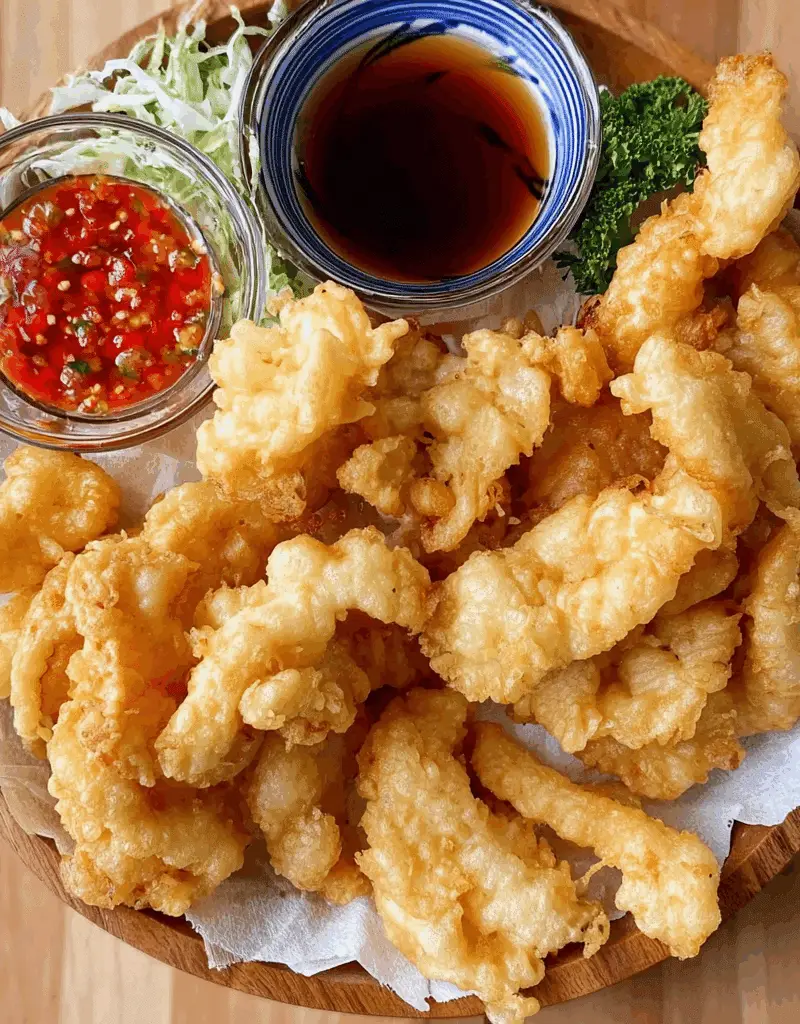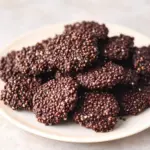If you’ve never had chicken tempura before, you’re in for a treat. Unlike heavier fried chicken, Japanese Chicken Tempura is made using an airy, ice-cold batter that fries up into an irresistibly crisp coating without feeling greasy or dense. It’s perfect when served fresh out of the fryer with a warm soy-based dipping sauce that adds just the right touch of umami and balance.
This dish is a brilliant way to bring a restaurant-quality Japanese meal to your kitchen in under 30 minutes. The secret lies in keeping the batter cold and the oil at the perfect temperature—these simple steps make all the difference. Pair it with steamed rice, miso soup, or some pickled veggies, and you’ve got a complete meal that’s light yet indulgent.
Full Recipe
Ingredients:
-
2 boneless skinless chicken breasts
-
1 cup all-purpose flour
-
1/2 cup cornstarch
-
1 tsp baking powder
-
1/2 tsp salt
-
1 egg
-
1 cup ice-cold sparkling water
-
Vegetable oil for deep frying
Dipping Sauce:
-
1/2 cup dashi stock
-
2 tbsp soy sauce
-
2 tbsp mirin
-
1 tsp grated ginger
Directions:
-
Slice chicken breasts into bite-sized strips or cubes and pat dry with paper towels.
-
In a mixing bowl, combine flour, cornstarch, baking powder, and salt.
-
In a separate bowl, lightly beat the egg and mix with ice-cold sparkling water.
-
Gently fold the wet mixture into the dry ingredients. Do not overmix – the batter should be slightly lumpy.
-
Heat oil in a deep pot to 340°F (170°C).
-
Dip chicken pieces into the batter, then gently drop them into the hot oil.
-
Fry in small batches for 3–4 minutes or until golden brown and cooked through.
-
Remove and drain on paper towels.
-
To make the dipping sauce, combine dashi, soy sauce, mirin, and grated ginger in a small saucepan and heat gently until warm.
-
Serve chicken tempura hot with dipping sauce on the side.
Prep Time: 15 minutes | Cooking Time: 15 minutes | Total Time: 30 minutes
Kcal: 295 kcal per serving | Servings: 4 servings
The Essence of Japanese Chicken Tempura
Japanese Chicken Tempura is a dish that embodies the elegance of simplicity, tradition, and technique. Unlike Western-style fried chicken, which tends to be heavy and greasy, Japanese tempura focuses on creating a light, crisp coating that enhances rather than overpowers the flavor of the meat. Originating from Japan’s Edo period, tempura was influenced by Portuguese missionaries and merchants who introduced deep-frying methods to Japanese cooking. Over time, the technique was perfected and adapted into something uniquely Japanese — subtle, artful, and deeply satisfying.
Chicken tempura, although not as traditional as shrimp or vegetable tempura, has become increasingly popular in modern Japanese cuisine. It offers a tender bite of protein encased in a delicate batter, perfect for pairing with dipping sauces, rice bowls, or bento boxes. This variation is particularly appreciated by those who want the tempura experience but prefer meat over seafood or vegetables.
Why the Batter Matters
The most defining feature of any tempura dish is its batter — airy, lacy, and lightly golden. This is not achieved by accident. The key is using ice-cold liquid (often sparkling water or club soda) combined with just a few dry ingredients, stirred minimally to avoid developing gluten. The result is a batter that crisps up immediately upon hitting hot oil, sealing in the moisture of the chicken while maintaining a remarkably light texture.
The inclusion of cornstarch and baking powder in the recipe helps to further lighten the batter and create those signature tempura “frills” — the little airy extensions that form on the edges when frying. The oil temperature is equally important. If it’s too low, the batter absorbs the oil and becomes greasy. If too hot, it burns before the chicken cooks through. Mastering this balance is what elevates chicken tempura from simple fried food to a refined culinary experience.
The Role of the Dipping Sauce
Traditional Japanese tempura is not served with a heavy sauce but with a light dipping sauce called tentsuyu, made with dashi (a Japanese soup stock), soy sauce, and mirin (a sweet rice wine). For chicken tempura, a touch of freshly grated ginger adds warmth and a bit of spice, perfectly balancing the richness of the fried coating.
The sauce is designed to enhance the tempura without overwhelming it. It seeps gently into the crevices of the batter and adds a savory depth that keeps every bite interesting. It’s not uncommon for tempura dishes to be served with grated daikon radish or chopped scallions as garnishes — both of which complement the dipping sauce beautifully.
Modern Variations and Serving Suggestions
While chicken tempura can be served on its own as an appetizer or snack, it’s often featured in more elaborate meals. In bento boxes, it might be nestled next to pickled vegetables, steamed rice, and tamagoyaki (a sweet rolled omelet). As a main dish, it pairs wonderfully with a simple green salad dressed in sesame or miso vinaigrette. For a heartier twist, chicken tempura can be served over a rice bowl (donburi) with a drizzle of sauce and a sprinkling of sesame seeds.
In modern fusion cuisine, some chefs are incorporating chicken tempura into tacos, wraps, and even sushi rolls. This versatility is part of its appeal — the dish can be dressed up or down depending on the occasion.
You might also find spicy mayo, yuzu aioli, or sweet chili sauce used as dipping options in contemporary settings. These non-traditional accompaniments provide a contrast to the classic flavor profile, making chicken tempura a flexible choice for creative home cooks and professional chefs alike.
Cooking Tips for Perfect Chicken Tempura
Even though the recipe is simple in terms of ingredients, achieving the perfect tempura requires attention to detail:
-
Keep the batter cold: The colder the batter, the better the crunch. If needed, place the bowl of batter inside a larger bowl filled with ice.
-
Do not overmix: Lumps are fine in tempura batter. Overmixing activates gluten, which results in a chewy rather than crispy texture.
-
Use the right oil: Neutral oils like vegetable, canola, or peanut oil work best. They have high smoke points and won’t overpower the flavor of the batter.
-
Fry in small batches: Overcrowding the pan drops the oil temperature, which makes the tempura soggy.
-
Drain properly: Use a wire rack or paper towels to remove excess oil right after frying. This ensures the coating stays crisp.
Cultural Context and Popularity
While tempura is deeply rooted in Japanese cuisine, it’s enjoyed all over the world. Chicken tempura, in particular, has become a favorite among Western diners who may be hesitant to try seafood-based dishes. It’s frequently found in Japanese-American restaurants and has made its way into various Asian fusion menus.
In Japan, tempura is often eaten during celebratory occasions or as part of a multi-course meal known as kaiseki. However, thanks to its relatively quick preparation and minimal ingredients, it’s also a popular homemade comfort food. The fact that it can be made in under 30 minutes makes it a go-to for busy families who still want to enjoy something special at dinnertime.
Nutritional Aspects and Considerations
Chicken tempura is certainly a fried dish, but it doesn’t have to be heavy or unhealthy. When made correctly, the batter absorbs very little oil, and chicken breast provides a lean source of protein. The dipping sauce is low in fat and sugar, relying instead on umami-rich ingredients that bring flavor without extra calories.
Those looking for gluten-free options can substitute rice flour or a gluten-free all-purpose blend in the batter. The key is to retain the lightness and cold temperature of the batter mixture. Additionally, air-frying is a modern alternative, though it may not deliver the exact crispiness that oil-frying achieves.
Making It a Family-Friendly Dish
Chicken tempura is a fantastic dish for family meals. Kids love the crunchy texture and mild flavor, while adults appreciate the elegance and customizable options. It can be a fun dish to prepare together, especially if you’re exploring Japanese cuisine at home. Allowing children to dip the chicken in the batter and watching it transform in the fryer is a hands-on way to introduce them to new food experiences.
Because it’s easy to scale up or down, chicken tempura works well for both small family dinners and larger gatherings. Serve it as finger food for a party with toothpicks and various dipping sauces, or build a dinner around it with soup, rice, and vegetables.
Conclusion
Japanese Chicken Tempura is a beautiful example of how traditional techniques and minimal ingredients can come together to create something truly special. From its feather-light batter to the flavorful dipping sauce, every bite is a testament to the balance and elegance of Japanese cooking.
This dish is not just about frying chicken — it’s about mastering texture, timing, and taste. Whether you’re looking to expand your cooking repertoire or simply crave a comforting, crunchy meal, chicken tempura is a recipe that never fails to impress. With just a few tips and some patience, you’ll be serving restaurant-quality tempura right from your own kitchen.








